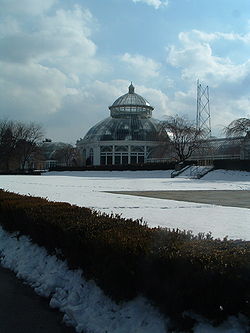New York Botanical Garden
The New York Botanical Garden is a prestigious botanical garden in New York City. One of the premier botanical gardens in the United States, it spans some 240 acres of Bronx Park in the borough of The Bronx and is home to some of the world's leading plant laboratories.
The Garden was founded in 1891 on part of the grounds of the Belmont Estate, formerly owned by the tobacco magnate Pierre Lorillard, after a fund-raising campaign led by Columbia University botanist Nathaniel Lord Britton, who was inspired to emulate the Royal Botanic Gardens in London.
The Garden is located at East 200th Street and Kazimiroff Boulevard and contains 48 different gardens and plant collections. Sightseers can easily spend a day admiring the serene cascade waterfall, wetlands and a 50 acre (200,000 m²) tract of never-harvested oaks, American beeches, cherry, birch, tulip and white ash trees — some more than two centuries old.
Garden highlights include an 1890s-vintage, wrought-iron framed, "crystal-palace style" greenhouse by Lord & Burnham; the Peggy Rockefeller memorial rose garden (originally laid out by Beatrix Farrand in 1916); a Japanese rock garden; a 37 acre (150,000 m²) conifer collection; extensive research facilities including a propagation center, 50,000-volume library, and an herbarium archive of over seven million botanical specimens dating back more than three centuries. At the heart of the Garden are 40 acres (162,000 m²) of virgin woodlands which represent the last stretch of the original forest which covered all of New York City before the arrival of European settlers in the 17th century. The forest itself is split by the Bronx River and includes a riverine canyon and rapids, and along its shores sits the landmark Lorillard snuff-grinding mill dating back to the 1840s.

The Pfizer Plant Research Laboratory, built with funding from the National Oceanic and Atmospheric Administration, New York State and New York City, and named for its largest private donor, is a major new research institution at the Garden that opened in 2006. The laboratory is a pure research institution, with projects more diverse than research in universities and pharmaceutical companies. The laboratory's research emphasis is on plant genomics, the study of how genes function in plant development. One question scientists hope to answer is Darwin's "abominable mystery"; when, where, and why flowering plants emerged. The laboratory's research also furthers the discipline of molecular systematics, the study of DNA as evidence that can reveal the evolutionary history and relationships of plant species. Staff scientists also study plant use in immigrant communities in New York City and the genetic mechanisms by which neurotoxins are produced in some plants, work that may be related to nerve disease in humans. A staff of 200 trains 42 doctoral students at a time from all over the world; since 1890s scientists from the New York Botanical Garden have mounted about 2,000 exploratory missions across the planet to collect plants in the wild. At the plant chemistry laboratory chemical compounds from plants are extracted to create a library of the chemistry of the world's plants and stored in a 768-square-foot DNA storage room with 20 freezers that store millions of specimens, including rare, endangered or extinct species. To protect them during winter power outages, there is a backup 300-kilowatt electric generator.
See also
- Education in New York City
- List of botanical gardens in the United States
- List of museums and cultural institutions in New York City
